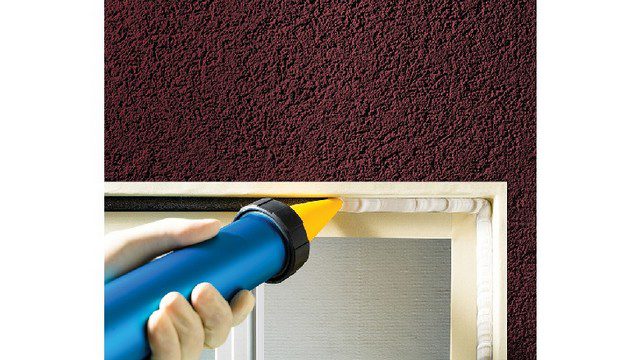Sealants are used to seal, block or close gaps between building materials to prevent fluids, air and other substances from passing through. The use of a high-quality sealant assists in creating a tight building envelope which improves energy-efficiency and occupant comfort of a building.
Comparing Construction Sealants
High-performing construction sealants offer durability, flexibility, ease of application, and sustainability. The building industry utilizes sealants with several different base chemistries including silicone, polyurethane, and polyether.
All types of sealant materials have positive attributes, but they also have limitations that result from the inherent chemical makeup of the products.
Silicone sealants may require solvent-based primers for certain substrates. The primers are often high VOC products which may require specific handling and application safeguards. The primers are typically not environmentally friendly and can be a concern during use, storage, disposal, or in the case of accidental spillage. Silicones cannot be coated with water-based products, which affects the cost of recoating a building with common architectural coatings. Silicones have a relatively sticky or tacky surface which tends to collect atmospheric dirt during its service life and can negatively impact the appearance of a building.
Polyurethane sealants have less UV durability than silicone or polyether sealants. They are susceptible to embrittlement, cracking, and fading when exposed to sunlight. Polyurethane sealants also may require a primer with the same negative aspects as primers used for silicone sealants.
Both silicone and polyurethane sealants break down into harmful chemicals if heated above their maximum operating temperatures and cannot be recycled.
Polyether-based sealants, like StoSeal STPE™Sealant, are fast curing and sustainable. They combine the strength of polyurethane and the weather resistance of silicone to create a long-lasting sealant with excellent strength, adhesion, and flexibility.
Polyether-based sealants maintain their color and appearance by natural UV resistance and by having a cured surface with high dirt-pickup resistance.
StoSeal STPE™Sealant bonds to most building materials (masonry, concrete, wood, stone, fiber cement, vinyl, stucco) and can seal gaps and joints around floor lines, wall penetrations, fixtures, etc., for a tight building envelope.

Comparing Silicone, Polyurethane, and Polyether Sealants
Silicone, polyurethane, and polyether-based sealants offer contractors readily available, easy-to-apply sealants. However, the right sealant depends on the environmental conditions and the project’s strength, aesthetics, and sustainability needs.
Silicone-Based Sealants
Silicone sealants’ soft and flexible nature conforms well to joints and provides high tensile strength. Silicone sealants also resist moisture, weather, UV rays, and high temperatures. However, they cannot be painted.
Pros of Silicone Sealants
- Abrasion and vibration resistance
- Good tensile strength
- Weather, temperature, and UV resistance
- Moisture resistance
- Broad applicability and can bond between most building materials
- Long-lasting
- No bubbles during curing
- Noncombustible silicone makes it applicable for fire-rated assemblies
- USDA-compliant silicone sealants allow its use inside food-processing facilities
- Pumpable silicone sealant offers easy application and cleanup
Cons of Silicone Sealant
- May require solvent primers for certain substrates
- Unpaintable
- Relatively high-cost
Polyurethane-Based Sealants
Flexible and paintable polyurethane sealant provides high cohesive strength that creates strong bonds and adherence to substrates and conforms well to joints. However, polyurethane sealants lack sufficient weather resistance and may break down when exposed to high temperatures and UV rays.
Polyurethane sealants are pumpable, and gun-grade. Polyurethane sealants are available in a wide range of hardnesses from Shore 35 A to Shore 70 D.
Two types of polyurethane sealants are available: one-component and two-component.
- One-component polyurethane sealant cures by exposure to moisture in the atmosphere. One-component polyurethane cures relatively slowly. These products are ready-to-use with conventional tools which is convenient for construction.
- Two-component polyurethane sealants offer faster curing and good performance. However, two-component products must be mixed in the field during use which requires special equipment, experience, and attention to detail. Field mixing also increases the opportunity for quality control problems and inconsistency of performance within the overall project.
Pros of Polyurethane Sealant
- Excellent cohesive and tensile strength and abrasion resistance
- High stability, wide adjustable range of performance
- Good adhesion, good strength, and tear resistance
- Good elasticity, excellent recovery, suitable for dynamic joints
- Excellent oil resistance
- Moderately priced
- Good flexibility under low-temperature conditions
- Will not freeze and crack in a cold environment
- Wide bonding range
Cons of Polyurethane Sealant
- UV exposure will cause the polyurethane sealant to crack and bubble.
- In elevated temperatures (above 80°C (176°F)), polyurethane will chemically break down, which diminishes its mechanical properties, like hardness and abrasion resistance.
- Polyurethane sealant may require priming.
- Polyurethane sealants lack sufficient water resistance, especially in alkaline water environments.
- Bubbles may form during curing that can compromise the adhesive bond.
- Two-component products have increased opportunities for problems caused by inconsistent or improper field mixing.
Polyether-based Sealants and Silyl Terminated Polyether (STPE)
Polyether-based sealants provide superior weather resistance, adhesion properties, and cure times by combining many of the benefits of silicone and polyurethane sealants. In addition, sustainable polyether sealants provide flexibility, durability, and tear—as well as temperature—resistance.
Silyl Terminated Polyether (STPE) incorporates silicon to provide advantageous characteristics of silicones attached to a flexible polyether backbone which provides beneficial properties similar to urethane sealants.
Silyl Terminated Polyether (STPE) sealant technology creates sealants with several superior high-performance features compared to polyurethane and silicone sealants:
- Durable and Weather Resistant: STPE sealants perform well in most weather conditions and at low temperatures (unlike polyurethane sealants) with no adhesion failures, cracking, splitting, or discoloration.
- Adhesion: STPE sealants provide superior cohesive strength, by adhering more effectively to many substrates, like concrete, metals, wood, plastics, and ceramics, compared to silicone and polyurethane sealants.
- Simple Application: STPE sealants bond well to most construction materials and may not require priming and can create a continuous smooth surface. In addition, STPE sealants can be painted after 24 hours.
- UV Resistant: STPE sealants will not crack or yellow after extended periods of UV-light exposure, unlike polyurethane sealants.
- Cold Resistant: STPE sealants retain their properties to -50°F (-45°C).
- Flexibility: STPE sealants’ elongation characteristics can endure structural movement and withstand substrate vibrations or oscillations more effectively than silicone sealants.
- Environmentally-Friendly: STPE products contain extremely low or no VOCs, unlike other sealants prone to off-gassing, like silicone and polyurethane, which will break down into harmful chemicals if heated past their maximum operating temperatures. STPE products are also recyclable.
- Non-Reactive: STPE sealants will not corrode or oxidize metals.
- Storage Stability: STPE sealants have an excellent shelf life when not exposed to moisture.
- Cure Rate: STPE sealants have a faster cure and tack-free time over other sealant types
StoSeal STPE™ High-Quality, Versatile Adhesive Sealant

StoSeal STPE™ from Sto Corp. is a high-quality, isocyanate-free, low-odor, one-part hybrid sealant with a VOC content of 8 grams per liter). It is a durable, flexible, low-modulus, and non-sag sealant with superior weathering and moisture resistance.
The excellent adhesive properties of StoSeal STPE™ Sealant work effectively with StoTherm® ci, StoPowerwall®, StoQuik®, and StoVentec® exterior wall systems and with StoGuard® water- and air-resistive barrier systems for new opaque wall and vertical above-grade building restoration applications.
Choosing the Best Sealant – StoSeal STPE Sealant
Selecting a high-performing and long-lasting sealant and applying it according to the manufacturer’s instructions is vital to creating a tight building envelope.
Sustainable polyether sealants, like StoSeal STPE™ Sealant, are a better sealant solution for most applications when compared to polyurethane and silicone sealants. It combines polyurethane’s strength and silicone’s weather resistance to produce a long-lasting sealant with excellent strength, UV resistance, adhesion, and flexibility. StoSeal STPE™ also offers excellent color stability and dirt pickup resistance which helps maintain an aesthetically pleasing building exterior.
For more on comparing silicone, polyurethane, and polyether sealants and the benefits of StoSeal STPE, contact our professionals at (800) 221-2397!


